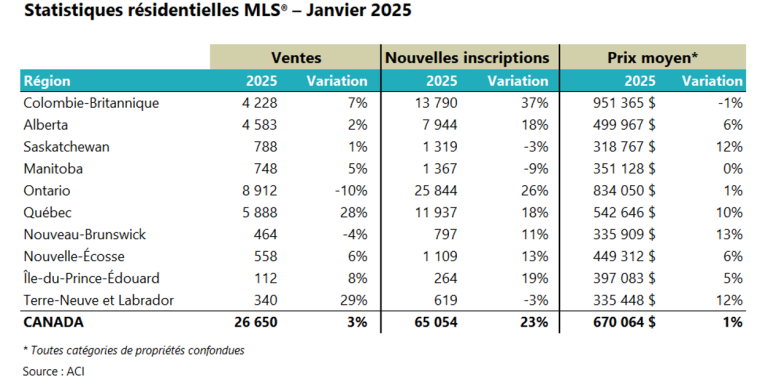Unlike what was observed in several other provinces, the resale market performed very well in Quebec last month. According to the latest statistics released by CREA, the number of sales recorded through various MLS® systems across the country in February 2025 fell by 10% nationwide, driven in particular by a sharp 27% drop in Ontario, as well as declines of 11% in Alberta and 10% in British Columbia. CREA attributes these results to the onset of a tariff war with the United States, which caused many buyers to hesitate.

Price drops were even observed in February in the two provinces where residential properties are the most expensive, with decreases of 3% and 2% in Ontario and British Columbia, respectively. Consequently, the national average price fell by 3%, to $668,097.
Quebec’s real estate market still on a roll…
February’s results, however, reveal a clear contrast in Quebec. Centris sales rose by 11% last month, marking the fourteenth consecutive monthly gain. In terms of prices, there was an 8% year-over-year increase, with the average price of residential properties of all types reaching $544,401 last month. The last price drop in Quebec dates back to June 2023.
…but for how much longer?
Despite these strong results, it’s fair to say that activity lost some momentum in February, as sales growth in the two previous months was around 28% (in January) and 51% (in December).
Quebec consumers’ confidence was also understandably shaken by the turmoil caused by the U.S. administration’s imposition of tariffs. According to the Conference Board of Canada’s confidence index, the proportion of Quebecers who believed it was a good time to make a major purchase such as a house or a car dropped from 19% in December 2024 to 14% in February 2025.[1]
Given the current context, it would be rather surprising if sales continued to rise for much longer. However, let’s not forget that interest rates are still on a downward trend. Spring will therefore remain an active season. One thing is certain: with a persistent shortage of properties for sale, market conditions still strongly favor sellers, and increased purchasing power due to lower financing costs, short-term price drops in the Quebec market are highly unlikely.
Saguenay and Trois-Rivières are the most vulnerable regions to tariffs
In Quebec, the only two metropolitan areas that experienced a decline in the number of transactions last month were Saguenay (-8%) and Trois-Rivières (-6%).

According to an analytical note from the Canadian Chamber of Commerce, which ranked Canadian cities most likely to be impacted by U.S. tariffs, Saguenay and Trois-Rivières topped the list in Quebec. The graph below shows the exposure of these two regions’ economies based on their exports to our southern neighbors. In particular, the Saguenay region accounts for about one-third of the country’s aluminum production, and 85% of that is exported to the United States. In addition to Saguenay and Trois-Rivières, the Drummondville region’s [2] economy could also be significantly affected by the tariffs. Conversely, the regions of Quebec City and Ottawa-Gatineau appear to be the least vulnerable, given their relatively low share of exports to Uncle Donald’s country.
If the trade war drags on, special attention should therefore be paid to the real estate markets in Saguenay, Trois-Rivières, and Drummondville.
[1] In Canada, these proportions stood at 14.4% and 12.7% in December 2024 and February 2025, respectively.
[2] CREA does not publish statistics for the Drummondville region. We’ll have to wait for the QPAREB’s quarterly data to get a better sense of the market there.


